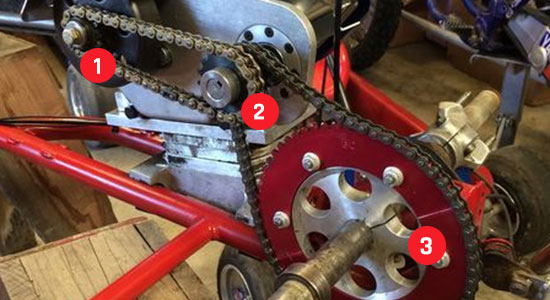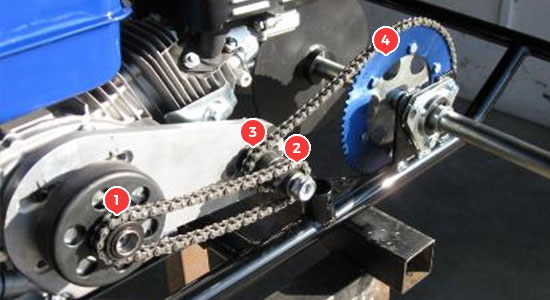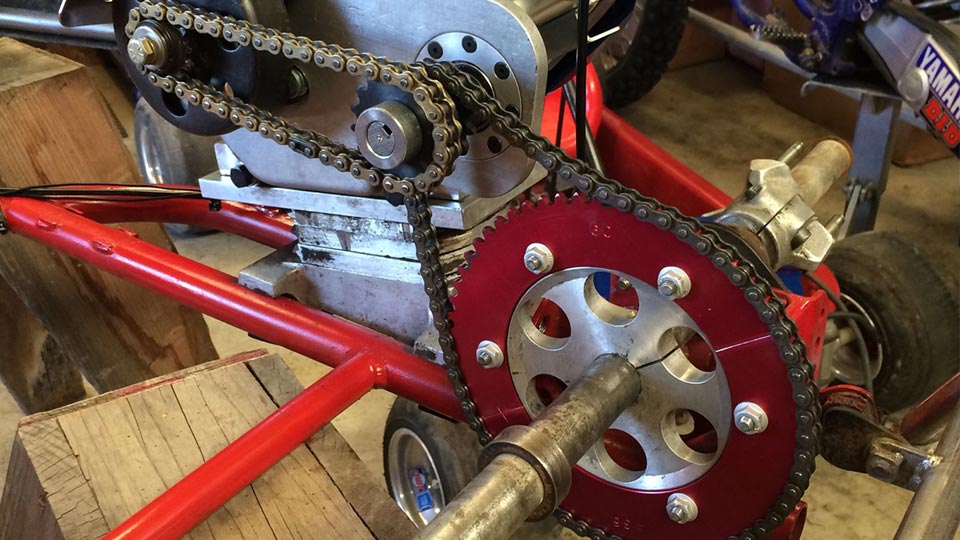A go-kart jackshaft is a mechanical component that transfers rotational force between the crankshaft and the axle. In essence, a jackshaft is a long shaft, which actually looks like an axle and is located in between the engine crankshaft and the rear axle. It’s sometimes also referred to as a countershaft, although the term jackshaft is more commonly used in the context of go-karting.
Generally speaking, jackshafts are a more common component in motorcycles, snowmobiles and farm implements. You’ll rarely find them on go-karts, unless you’re running a torque converter setup. Without taking away too much now, a jackshaft is required if the engine and the rear axle don’t align correctly. In this article, we’ll be exploring the purpose of jackshafts on go-karts, if you should be running a jackshaft on your kart, what a jackshaft kit is.
What is the purpose of a Jackshaft on a Go-Kart?
With a traditional go-kart setup, the engine generates mechanical power that turns the crankshaft. The crankshaft transfers the rotational power to the axle with the use of two sprockets and a roller chain. The difference with a go-kart jackshaft setup is that in between the crankshaft and the axle, there is a jackshaft with two additional sprockets. This means that the crankshaft transfers its rotational power to a jackshaft, instead of directly to the axle. The jackshaft then transfers the rotational power to the rear axle with the use of its two additional sprockets and a chain.
By now, you’re probably wondering what the purpose of a jackshaft is on a go-kart. Well, there are several reasons why some go-karts run a jackshaft setup. The main reason is because it allows a go-kart to operate without the axle being aligned with the crankshaft. This means that the power source can be at a different location and both crankshaft sprocket and axle sprocket do not need to align.
Additionally, you’ll be using a jackshaft if you are running a torque converter on your go-kart. The driven unit of a torque converter acts like a jackshaft, as the two pulleys are connected via a belt, and the driven unit with the rear axle sprocket with a chain.

In This Illustration:
- Crankshaft
- Jackshaft
- Rear Axle
A jackshaft is not required for racing go-karts but is intended for off-road go-karts or homemade go-karts that aren’t able to align the crankshaft with the axle directly or have a torque converter. It’s more common in motorcycles and snowmobiles. Due to their narrow frames and wider wheels, they need a jackshaft to create the alignment. As said, the same can be said for some off-road go-karts and you can see this in the illustration below.
Should I install a Jackshaft for my Go-Kart?
Well, the answer to this really depends. As you now know the main reason for running a jackshaft setup, there are also other benefits. It also gives you more flexibility to gear your sprockets, as you have a total of four instead of two. Secondly, due to the jackshaft acting as a pulley, it reduces the physical stress on the sprockets and chain. This is because instead of three components, the load is now spread across six.
However, don’t forget that the extra friction means that your go-kart will experience a minor power loss. Additionally the increased moving parts mean more maintenance and more things that could go wrong. If you’re building a go-kart yourself or working on an off-road go-kart, I suggest that you only opt for a jackshaft setup out of necessity. If you have no other way to align the crankshaft with the axle, then you should consider it. It does require a little bit of planning and customization, but it’s an effective way to align the power source with the axle.
To reiterate, racing go-karts do not require a jackshaft, as they’re laid out in a way to facilitate the alignment between the crankshaft and the axle by the use of two sprockets and a chain (or a torque converter or clutch).
How Do You Calculate the Jackshaft Ratio?
If you have decided to go for a jackshaft setup for your go-kart, you’ll need to calculate the jackshaft ratio. In simple terms, the jackshaft ratio is the sprocket ratio between all four sprockets. Keep in mind that instead of the traditional two sprockets, you now have to account for four.
Jackshaft Ratio: Ratio A x Ratio B
- Ratio A: Teeth of Jackshaft In Sprocket / Teeth of Crankshaft Sprocket
- Ratio B: Teeth of Axle In Sprocket / Teeth of Jackshaft Out Sprocket
In order to calculate the jackshaft ratio for your go-kart you need to calculate the both sprocket ratios and multiply them. You start by dividing the number of teeth of the jackshaft by the number of teeth on the crankshaft sprocket. Let’s call it Sprocket Ratio A. Then you divide the axle sprocket teeth by the amount of teeth on the jackshaft out sprocket. Let’s call this Ratio B. Now simply multiply Ratio A and Ratio B to get the final ratio.

Jackshaft Description
- Crankshaft Sprocket
- Jackshaft In Sprocket
- Jackshaft Out Sprocket
- Axle Sprocket
What is a Jackshaft Kit for Go-karts?
If you’re planning on running a jackshaft setup for your go-kart, I recommend that you purchase a kit instead of individual parts. A jackshaft kit contains the jackshaft, key way, two sprockets, two bearings, two bearing hangers, collar and a key stock. If you get the individual parts yourself, you’ll need to match the item dimensions, which could take quite a while. There are two jackshaft kits I recommend, the 35 Chain Go-Kart Jackshaft Kit (For a 35 chain size) or the 40, 41 & 420 Chain Go-Kart Jackshaft Kit (For a 40, 41 & 420 chain size). The benefit of a jackshaft kit is that all items are compatible with each other. You’ll only be required to set this up yourself.
Jackshaft Go-Kart Setups
Go-kart jackshafts have an application for the reasons mentioned above. Below, are some examples of different types of go-karts using a jackshaft setup. You’ll be able to see how their setup looks like and why they decided to install a jackshaft instead of a traditional crankshaft-to-axle setup.
1. Gas Pedal Garage’s Off-Road Go-Kart
Gas Pedal Garage is running a jackshaft setup on his off-road go-kart. You can see that he had to run a jackshaft on his build, as he isn’t able to connect the axle directly to the power source. This is due to the slim frame and the fact that he is running drive shafts on each side. Overall, this is a great build and a good showcase for jackshaft setups.
More Information
- Owner: Gas Pedal Garage
- Go-Kart Type: Off-Road
- Configuration: Jackshaft
- Link: YouTube Link
2. balabay77’s Racing Go-Kart
Balabay77 runs an interesting jackshaft setup on a racing go-kart. Jackshafts are generally not required for racing go-karts where the frame is wide enough to run with a traditional setup instead. However, this was a fun project for them. This video is great because you get to see how they build the frame and mount, as well.
More Information
- Owner: balabay77
- Go-Kart Type: Racing Go-Kart
- Configuration: Jackshaft
- Link: YouTube Link
3. jeep2003’s Custom Go-Kart
Jeep2003 built an awesome homemade go-kart. In this video you’ll see that the narrow body and the position of the engine makes it impossible to run a chain directly from the crankshaft sprocket to the rear axle sprocket. For this kind of scenario a jackshaft is the perfect solution, as he can position it so the frame doesn’t obstruct the axle sprocket.
More Information
- Owner: jeep2003
- Go-Kart Type: Custom Go-Kart
- Configuration: Jackshaft
- Link: YouTube Link
How to Maintain a Go-Kart Jackshaft
Maintaining a go-kart jackshaft is very important, as they are responsible for transferring the rotational power from the crankshaft to the rear axle. If the jackshaft isn’t maintained well, it can lead to loss in power and potential go-kart damage if your chair breaks. It’s therefore recommended to check your jackshaft every time you do your regular go-kart maintenance.
The first thing you should check is for wear and tear. Check for wear on the chain and sprockets. You should also regularly apply lubricant on your chain, to ensure it runs smoothly. A simple chain lubricant will do. If the chains and the sprockets are worn, replace them with a new set.
I always replace the sprockets and the chain at the same time, as they have similar wear rates on my go-kart. As jackshafts have closed bearings, you’ll just need to spin the jackshaft to ensure that they are still running smoothly and are not damaged. You should also check that the jackshaft moves smoothly and there isn’t any apparent noise.
Go-Kart Jackshaft Maintenance Summary:
- Ensure that the sprockets are in good shape
- Check chains for any wear
- Lubricate both chains properly
- Make sure that bearings run smoothly
- Ensure that there are no apparent noises
Conclusion
I hope that you enjoyed the article on go-kart jackshafts. As you’re aware by now, jackshafts on go-karts aren’t that common, but they do have an application. If the axle sprocket doesn’t align with the crankshaft sprocket, a jackshaft is an excellent solution. They also offer a few other benefits, such as less stress on the chain and sprockets. If you opt for a jackshaft setup, I highly recommend opting for a go-kart jackshaft kit. This will greatly simplify the component selection and save you a lot of time that you should rather spend on installing it.

